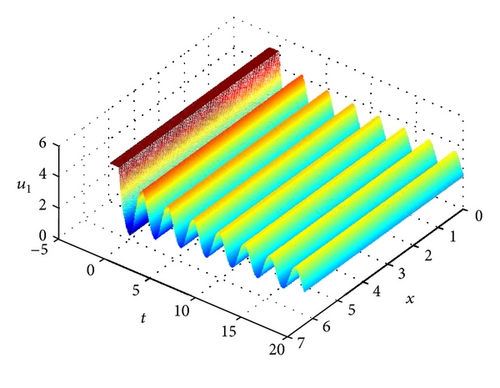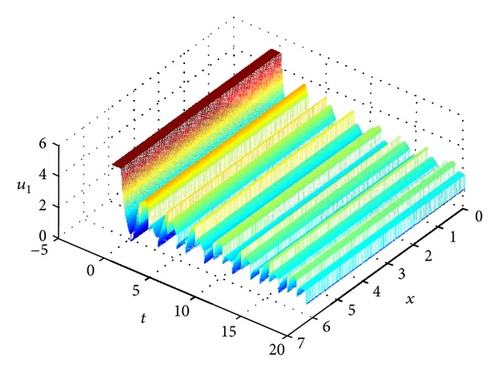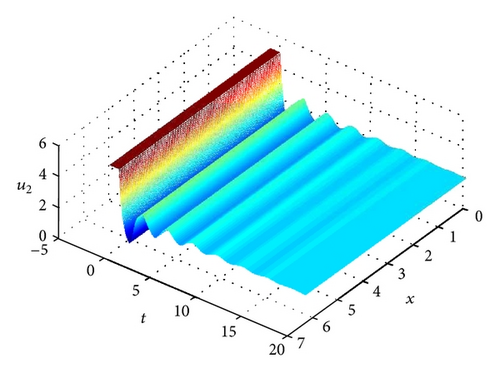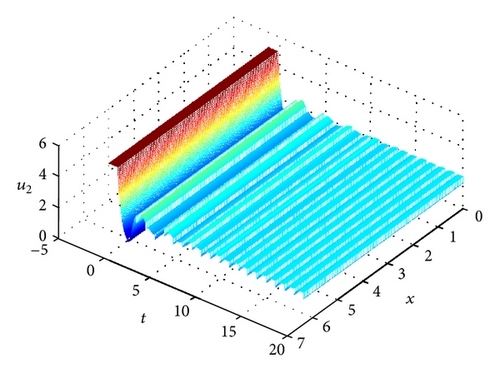Exponential Stability and Periodicity of Fuzzy Delayed Reaction-Diffusion Cellular Neural Networks with Impulsive Effect
Abstract
This paper considers dynamical behaviors of a class of fuzzy impulsive reaction-diffusion delayed cellular neural networks (FIRDDCNNs) with time-varying periodic self-inhibitions, interconnection weights, and inputs. By using delay differential inequality, M-matrix theory, and analytic methods, some new sufficient conditions ensuring global exponential stability of the periodic FIRDDCNN model with Neumann boundary conditions are established, and the exponential convergence rate index is estimated. The differentiability of the time-varying delays is not needed. An example is presented to demonstrate the efficiency and effectiveness of the obtained results.
1. Introduction
The fuzzy cellular neural networks (FCNNs) model, which combines fuzzy logic with the structure of traditional neural networks (CNNs) [1–3], has been proposed by Yang et al. [4, 5]. Unlike previous CNNs structures, the FCNNs model has fuzzy logic between its template and input and/or output besides the “sum of product” operation. Studies have shown that the FCNNs model is a very useful paradigm for image processing and pattern recognition [6–8]. These applications heavily depend on not only the dynamical analysis of equilibrium points but also on that of the periodic oscillatory solutions. In fact, the human brain is naturally in periodic oscillatory [9], and the dynamical analysis of periodic oscillatory solutions is very important in learning theory [10, 11], because learning usually requires repetition. Moreover, an equilibrium point can be viewed as a special periodic solution of neural networks with arbitrary period. Stability analysis problems for FCNNs with and without delays have recently been probed; see [12–22] and the references therein. Yuan et al. [13] have investigated stability of FCNNs by linear matrix inequality approach, and several criteria have been provided for checking the periodic solutions for FCNNs with time-varying delays. Huang [14] has probed exponential stability of fuzzy cellular neural networks with distributed delay, without considering reaction-diffusion effects.
Strictly speaking, reaction-diffusion effects cannot be neglected in both biological and man-made neural networks [19–32], especially when electrons are moving in noneven electromagnetic field. In [19], stability is considered for FCNNs with diffusion terms and time-varying delay. Wang and Lu [20] have probed global exponential stability of FCNNs with delays and reaction-diffusion terms. Song and Wang [21] have studied dynamical behaviors of fuzzy reaction-diffusion periodic cellular neural networks with variable coefficients and delays without considering pulsing effects. Wang et al. [22] have discussed exponential stability of impulsive stochastic fuzzy reaction-diffusion Cohen-Grossberg neural networks with mixed delays. Zhao and Mao [30] have investigated boundedness and stability of nonautonomous cellular neural networks with reaction-diffusion terms. Zhao and Wang [31] have considered existence of periodic oscillatory solution of reaction-diffusion neural networks with delays without fuzzy logic and impulsive effect.
As we all know, many practical systems in physics, biology, engineering, and information science undergo abrupt changes at certain moments of time because of impulsive inputs [33]. Impulsive differential equations and impulsive neural networks have been received much interest in recent years; see, for example, [34–42] and the references therein. Yang and Xu [36] have investigated existence and exponential stability of periodic solution for impulsive delay differential equations and applications. Li and Lu [38] have discussed global exponential stability and existence of periodic solution of Hopfield-type neural networks with impulses without reaction-diffusion. To the best of our knowledge, few authors have probed the existence and exponential stability of the periodic solutions for the FIRDDCNN model with variable coefficients, and time-varying delays. As a result of the simultaneous presence of fuzziness, pulsing effects, reaction-diffusion phenomena, periodicity, variable coefficients and delays, the dynamical behaviors of this kind of model become much more complex and have not been properly addressed, which still remain important and challenging.
Motivated by the above discussion, we will establish some sufficient conditions for the existence and exponential stability of periodic solutions of this kind of FIRDDCNN model, applying delay differential inequality, M-matrix theory, and analytic methods. An example is employed to demonstrate the usefulness of the obtained results.
Notations. Throughout this paper, ℝn and ℝn×m denote, respectively, the n-dimensional Euclidean space and the set of all n × m real matrices. The superscript “T” denotes matrix transposition and the notation X ≥ Y (resp., X > Y), where X and Y are symmetric matrices, means that X − Y is positive semidefinite (resp., positive definite). Ω = {x = (x1, …, xm) T, |xi | < μ} is a bounded compact set in space ℝm with smooth boundary ∂Ω and measure mes Ω > 0; Neumann boundary condition ∂ui/∂n = 0 is the outer normal to ∂Ω; L2(Ω) is the space of real functions Ω which are L2 for the Lebesgue measure. It is a Banach space with the norm , where u(t, x) = (u1(t, x), …,un(t, x)) T, ∥ui(t, x)∥2 = (∫Ω | ui(t, x)|2dx) 1/2, |u(t, x)| = (|u1(t, x)|, …, |un(t, x) | ) T. For function g(x) with positive period ω, we denote . Sometimes, the arguments of a function or a matrix will be omitted in the analysis when no confusion can arise.
2. Preliminaries
-
(H1) There exists a positive diagonal matrix F = diag (F1, F2, …, Fn), and G = diag (G1, G2, …, Gn) such that
() -
for all x ≠ y, j = 1,2, …, n.
-
(H2) ci(t) > 0, aij(t), bij(t), αij(t), βij(t), Tij(t), Hij(t), vi(t), Ii(t), and τj(t) ≥ 0 are periodic function with a common positive period ω for all t ≥ t0, i, j = 1,2, …, n.
-
(H3) For ω > 0, i = 1,2, …, n, there exists q ∈ Z+ such that tk + ω = tk+q, Iik(ui) = Ii(k+q)(ui) and Iik(ui(tk, x)) are Lipschitz continuous in ℝn.
Definition 1. The model in (1) is said to be globally exponentially periodic if (i) there exists one ω-periodic solution and (ii) all other solutions of the model converge exponentially to it as t → +∞.
Definition 2 (see [26].)Let C = ([t − τ, t], ℝn), where τ ≥ 0 and F(t, x, y) ∈ C(ℝ+ × ℝn × C, ℝn). Then the function F(t, x, y) = (f1(t, x, y), f2(t, x, y), …, fn(t, x, y)) T is called an M-function, if (i) for every t ∈ ℝ+, x ∈ ℝn, y(1) ∈ C, there holds F(t, x, y(1)) ≤ F(t, x, y(2)), for y(1) ≤ y(2), where and ; (ii) every ith element of F satisfies fi(t, x(1), y) ≤ fi(t, x(2), y) for any y ∈ C, t ≥ t0, where arbitrary x(1) and x(2) (x(1) ≤ x(2)) belong to ℝn and have the same ith component . Here, .
Definition 3 (see [26].)A real matrix A = (aij) n×n is said to be a nonsingular M-matrix if aij ≤ 0 (i ≠ j; i, j = 1, …, n) and all successive principal minors of A are positive.
Lemma 5 (see [26].)Assume that F(t, x, y) is an M-function, and (i) x(t) < y(t), t ∈ [t − τ, t0], (ii) D+y(t) > F(t, y(t), ys(t)), D+x(t) ≤ F(t, x(t), xs(t)), t ≥ t0, where xs(t) = sup −τ≤s≤0x(t + s), ys(t) = sup −τ≤s≤0y(t + s). Then x(t) < y(t), t ≥ t0.
3. Main Results and Proofs
We should first point out that, under assumptions (H1), (H2), and (H3), the FIRDDCNN model (1) has at least one ω-periodic solution of [26]. The proof of the existence of the ω-periodic solution of (1) can be carried out similar to [26, 28] by the nonlinear functional analysis methods such as topological degree and here is omitted. We will mainly discuss the uniqueness of the periodic solution and its exponential stability.
Theorem 6. Assume that (H1)–(H3) holds. Furthermore, assume that the following conditions hold
-
(H4) is a nonsingular M-matrix.
-
(H5) The impulsive operators hk(u) = u + Ik(u) is Lipschitz continuous in ℝn; that is, there exists a nonnegative diagnose matrix Γk = diag (γ1k, …, γnk) such that |hk(u) − hk(u*)| ≤ Γk | u − u*| for all u, u* ∈ ℝn, k ∈ N+, where |hk(u)| = (|h1k(u1)|, …, |hnk(un) | ) T, Ik(u) = (I1k(u1), …,Ink(un)) T.
-
(H6) , where ηk = max 1≤i≤n {1, γik}, k ∈ N+.
Proof. For any ϕ, ψ ∈ PCΩ, let u(t, x, ϕ) = (u1(t, x, ϕ), …, un(t, x, ϕ)) T be a periodic solution of the system (1) starting from ϕ and u(t, x, ψ) = (u1(t, x, ψ), …, un(t, x, ψ)) T, a solution of the system (1) starting from ψ. Define
Multiplying both sides of (6) by Ui and integrating it in Ω, we have
Remark 7. When ci(t) = ci, aij(t) = aij, bij(t) = bij, αij(t) = αij, βij(t) = βij, Tij(t) = Tij, Hij(t) = Hij, vi(t) = vi, Ii(t) = Ii, and τt = τi(ci, aij, bij, αij, βij, Tij, Hij, vi, Ii, and τi are constants), then the model (1) is changed into
Remark 8. If Ik(·) = 0, the model (1) is changed into
4. Numerical Examples
Example 9. Consider a two-neuron FIRDDCNN model:




5. Conclusions
In this paper, periodicity and global exponential stability of a class of FIRDDCNN model with variable both coefficients and delays have been investigated. By using Halanay’s delay differential inequality, M-matrix theory, and analytic methods, some new sufficient conditions have been established to guarantee the existence, uniqueness, and global exponential stability of the periodic solution. Moreover, the exponential convergence rate index can be estimated. An example and its simulation have been given to show the effectiveness of the obtained results. In particular, the differentiability of the time-varying delays has been removed. The dynamic behaviors of fuzzy neural networks with the property of exponential periodicity are of great importance in many areas such as learning systems.
Acknowledgments
The authors would like to thank the editors and the anonymous reviewers for their valuable comments and constructive suggestions. This research is supported by the Natural Science Foundation of Guangxi Autonomous Region (no. 2012GXNSFBA053003), the National Natural Science Foundations of China (60973048, 61272077, 60974025, 60673101, and 60939003), National 863 Plan Project (2008 AA04Z401, 2009 AA043404), the Natural Science Foundation of Shandong Province (no. Y2007G30), the Scientific and Technological Project of Shandong Province (no. 2007GG3WZ04016), the Science Foundation of Harbin Institute of Technology (Weihai) (HIT (WH) 200807), the Natural Scientific Research Innovation Foundation in Harbin Institute of Technology (HIT. NSRIF. 2001120), the China Postdoctoral Science Foundation (2010048 1000), and the Shandong Provincial Key Laboratory of Industrial Control Technique (Qingdao University).




